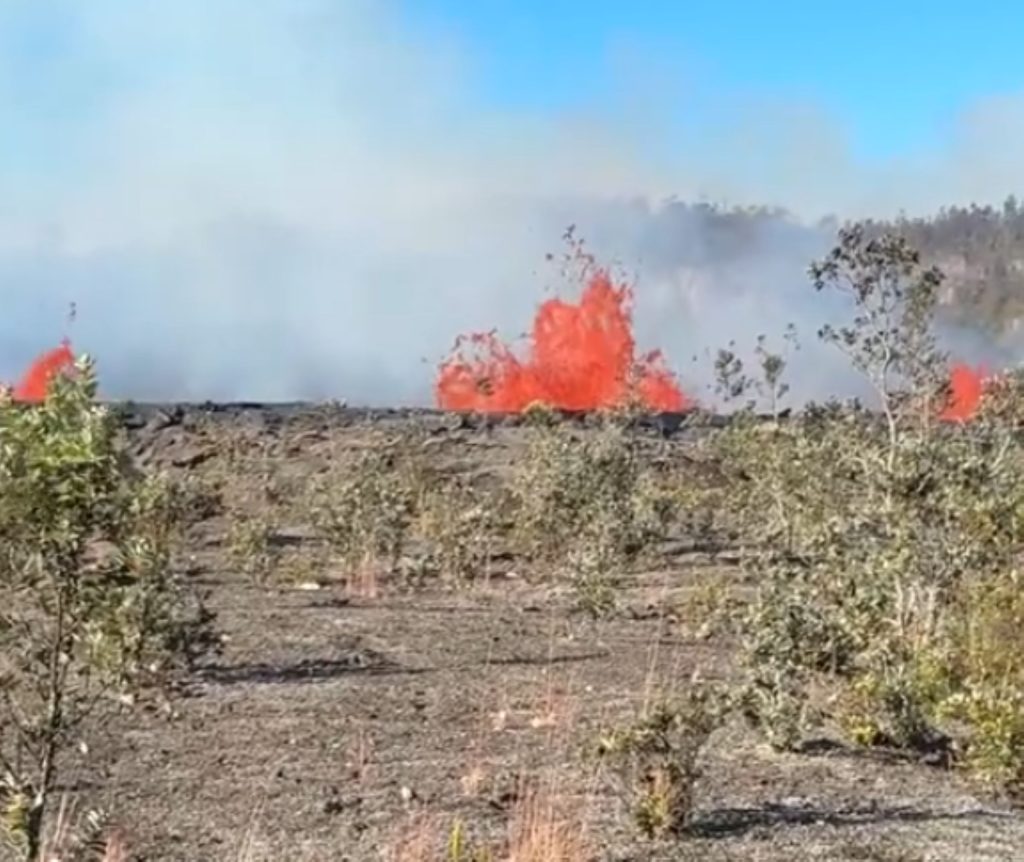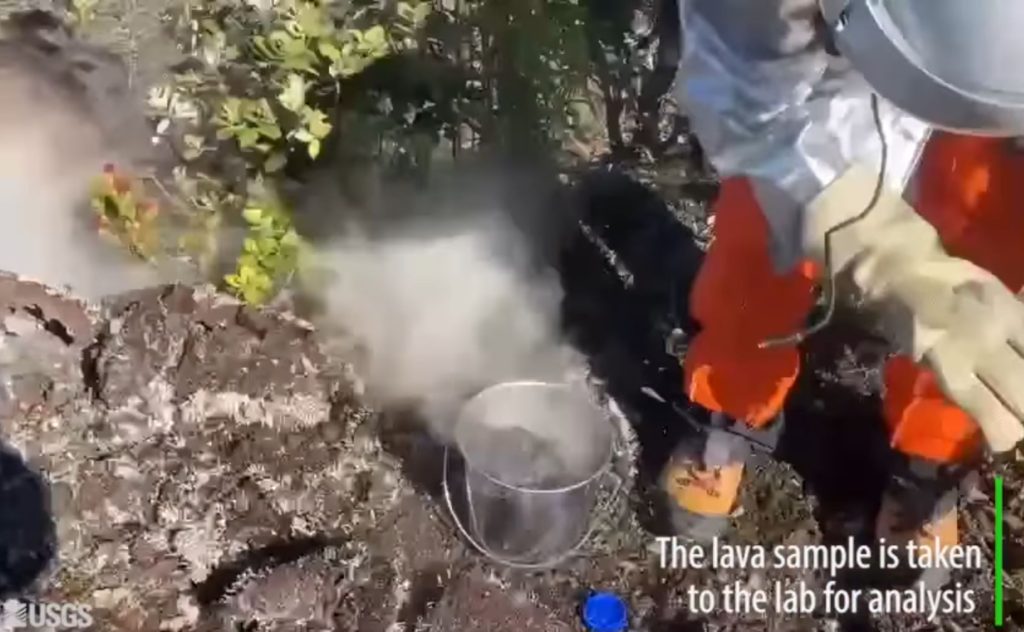‘Aloha, Tūtū Pele’: Excitement abounds as latest Kīlauea eruption continues; public viewing not possible now
As lava fountained Tuesday, erupting from several fissures in Nāpau Crater in the middle East Rift Zone of the Big Island’s Kīlauea volcano, reaching heights of up to about 10 yards, many questions flowed in via social media to Hawai‘i Volcanoes National Park officials and Hawaiian Volcano Observatory researchers.

Inquiries ranged from seeking more scientific knowledge such as why smoke from the now 3-day-old eruption was blue at one point to infrastructure queries about whether certain park features were damaged by the new lava flows.
The national park, however, addressed head-on perhaps one of the most pondered questions each time an eruption happens on one of the island’s volcanoes.
“Where can I see the eruption?”
Unfortunately, no public viewing site of the Nāpau Crater eruption is possible right now, the park reported in a Facebook post shortly before 11 a.m. Tuesday.
It is happening in a remote and closed wilderness area inside Hawai‘i Volcanoes National Park more than 6 miles from the nearest road.
Lava is erupting on the floor of the crater, located just west of the 1983-2018 Pu‘u‘ō‘ō eruption site, and while it is happening along the Nāpau trail, the area is not accessible.
The park also closed Chain of Craters Road and all access along the roadway because of hazards associated with the eruption.
“We are currently evaluating hazards such as wildland fire, gas emissions and flow direction with our Hawaiian Volcano Observatory partners,” said Hawai‘i Volcanoes National Park in its post.
The Kīlauea summit area and other parts of the park, however, remain open.
Just because no public viewing is available won’t mean some might not scoff at closures, ignore hazards, shrug off unsafe conditions and attempt to trek to the new flowing lava field anyway, which as of 8:30 a.m. Tuesday had already covered about 25% to 30% of Nāpau Crater floor.
“The path of the lava flow is going through the park. The hiking trails affected are closed off now, though there are sometimes tourists who ignore the warnings and always want to get too close to the lava for selfies,” commented Capitola Sommer on a Facebook post Monday by Hawai‘i Volcanoes National Park.
Big Island police arrested dozens of people for trespassing to illegally take selfies in restricted areas near lava flows 6 years ago during Kīlauea’s 2018 lower East Rift Zone eruption.
Estimates from the state showed at least 40 people were arrested by mid-June that year for loitering in a lava zone. The eruption began May 3.
Not even the possibility of thousands of dollars in fines and up to a year in jail deterred the seemingly steady supply of selfie seekers.
There were humans at the Nāpau Crater eruption site Tuesday morning, however, but they weren’t there to just view the lava and take pictures.
Chris Colby commented if anyone else tried to do the same, they’d be fined.
“And likely get your fingers burned too!” the Hawaiian Volcano Observatory replied in the same thread on its 10:14 a.m. Facebook post. “The work being done by [Hawaiian Volcano Observatory] in this area is with permission from the [National Park Service].”
Hawaiian Volcano Observatory geologists earlier Tuesday morning traveled to the crater by helicopter to collect fresh lava samples for lab analysis, which will provide information about conditions in the magmatic system and magma’s pathway to the surface of the volcano.
“The geologist put molten lava into a metal bucket and rapidly quenched it with water,” said the volcano observatory. “The fast quench is needed to preserve the geochemistry of the fresh sample and prevent changes that would result from the formation of crystals during slow cooling.”
Betsy Gressler asked why the shovel and bucket used to collect the sample didn’t start to melt. Sonia Bartholomew’s students asked the same question while they watched the video accompanying the post during Earth Science class.
Was it because it all happened so fast? The Hawaiian Volcano Observatory said almost.
Steel’s melting point is somewhere about 2,500 to 2,800 degrees, depending on the grade. Hawai’i’s basaltic lava usually erupts at 2,140 degrees, so not quite hot enough to liquify the shovel. The bucket is also likely galvanized steel with a melting point of 2,190 degrees, just a tad higher than lava’s temp.
“And once the molten lava hits the water, its temperature decreases drastically, so it’s never quite in contact with the bucket or canister,” said the volcano observatory, adding, yes, the geologists also do move fast.
Bartholomew said she can’t wait to share the answer with her students: “So cool.”
Others were envious of the geologists and their eruption escapade.
“This has been on my bucket list [no pun intended] ever since I wanted to become a volcanologist,” commented Travis Boser.
Even if you can’t get to the actual site, there are a few ways to see the eruption yourself.
Some people suggested taking a helicopter ride.
Arlene Buklarewicz commented on one of Hawai‘i Volcanoes National Park’s Facebook posts Tuesday that commercial helicopter flights are allowed over the park from 10 a.m. to 2 p.m. Mondays, Tuesdays, Thursdays and Fridays, with some altitude restrictions.
“They’re not going to be flying low over it,” added Chris Colby.
The public asked and the Hawaiian Volcano Observatory listened, too.
A new webcam was installed Tuesday that provides a live view of Nāpau Crater that’s now available for everyone to watch online.
The view is looking to the southwest, with the image updated every 15 minutes so you’ll never miss any of the eruption action.
“Awesome!!” exclaimed Yvonne Baur on the volcano observatory’s Facebook post announcing the new webcam. “Big mahalo … you just made my day!!”

You can also follow the Hawaiian Volcano Observatory and Hawai‘i Volcanoes National Park on social media to catch any videos, photos and other multi-media they post of the eruption.
Start by visiting their websites (click the hyperlinks above) and then scroll to find and connect to the links for their Facebook, Instagram and X pages as well as other platforms.
While the Hawaiian Volcano Observatory said in a reply to a question on Facebook that it does not appear the Nāpau trail was damaged by the fissures, park officials in replying to another question about whether the eruption threatens the trail and nearby campsites said conditions will be evaluated on-site as soon as it is safe and updates will be shared as information is confirmed.
The new lava flows are happening close to the campground and a cultural site.
As for other concerns commenters asked about such as Nāhuku, also known as the Thurston Lava Tube, and the Kīlauea Iki trail, Hawai‘i Volcanoes National Park said they are located north of Chain of Craters Road and along Crater Rim Drive, which remains open.
The eruption does not pose a threat to human life or infrastructure; however, continued gas emissions could cause issues for people living, working or spending extended periods of time downwind from the eruption site.
“Potential hazards continue to be volcanic gases that create vog, localized ground cracks and subsidence features, methane explosions from vegetation ‘cooking’ beneath lava flows and Pele’s hair and other lightweight volcanic glass fragments wafting downwind,” said a Hawaiian Volcano Observatory post at 1 p.m. on Facebook.
Vog was another question several people asked about Tuesday, especially West Hawai‘i residents, who often end up dealing with the brunt of the volcanic fog.
A couple of Kona residents commenting on the Hawai‘i Volcanoes National Park post from just before 11 a.m. said they hadn’t seen any yet. Bill Shaughnessy agreed and said, surprisingly, none had made its way into the skies above Ocean View by before noon.
“It’s actually pretty bad already,” disagreed Ruth Honu of Kailua-Kona. “I could see it below us this morning, as we are at 1,500-foot elevation. I notice it right away, as I have asthma. Hopefully, it just stops as quickly as it started.”
About an hour later, around 12:30 p.m., Christy Mulvey commented she hadn’t seen any vog yet, but it was “really cloudy, so you really can’t tell.” Kristina Anderson wrote about 45 minutes later to “check purple air.”
Information about the volcano, hazards and status updates can be found here.
It seems people are for the most part overall excited about the new eruption, which started its third phase between 4 and 5 a.m. Tuesday.
The system of several fissures spanned about 0.3 of a mile in Nāpau Crater as of the Hawaiian Volcano Observatory’s latest report yesterday and cuts east-west across the northern crater floor.
Eruptive activity began late Sunday and was preceded by intense and localized earthquakes between Maunaulu and Makaopuhi Crater accompanied by ground deformation patterns that indicated a shallow underground intrusion of magma.

“It is difficult to say how long the eruptive activity may continue,” the Hawaiian Volcano Observatory said in its 1 p.m. Facebook post. “Summit deflation recorded by tiltmeters indicate[s] a constant transfer of magma from the summit to the eruption site. As long as magma is being supplied to the middle East Rift Zone, the eruptive activity is likely to continue.”
Commenters used words such as “cool” and “awesome” to describe what they thought about the eruption. Shawn Noe said Hawaiian volcano goddess Pele teased everyone for so long, she was finally putting on a show.
Donna Carey extolled Madame Pele’s beauty in sharing on Facebook an image of the eruption that had been posted elsewhere on social media.
Kay Laxson Berry on Monday commented that the eruption is the beginning of an exciting adventure. Carolyn Olson simply said: “Oh, Pele!”
“Love that this is in an area that does not affect people’s land and livelihoods,” commented Samten Palmo. “Aloha, Tūtū Pele.”
Sponsored Content
Comments




















